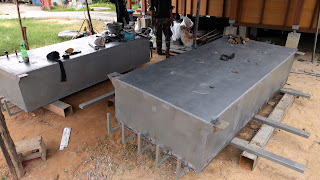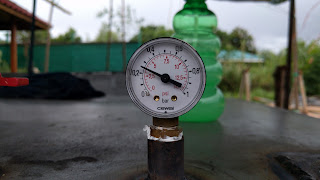On the first pontoon pressure test a few days ago, we found that the main leak point was the large inspection tube. The issue was that it was cast iron rather than steel, making the welded seam less perfect than a steel-to-steel weld. But being on the top, it would never be submerged under water in normal operation, and we ought to be able to source a steel alternative somewhere anyway.
So I was very pleased to find only one small hole on any of the main surface seams. This was fixed in only a few minutes.
We then went ahead and removed the large inspection tube and welded on a piece of scrap steel plate to make it airtight and tried the pressure experiment again. I really want to see if we could confirm that the pontoon is now mostly airtight. (And thus watertight.)
The real question is that since a tiny bit of leakage is inevitable (nothing is perfect, and even just through the thread to the pressure gauge there should be some tiny amount of leakage). So how much leakage is too much? Should the pressure last an hour? Or a day?
At this point, I don’t really know yet, but less is presumably better.
So for the second test, we pumped the pontoon up to 3.5psi again yesterday at around 14.20:
Look carefully at the tip of the needle in relation to the 0.25 bar line. You can see that the upper edge of the needle lines up with 0.25 bar line almost perfectly.
Then, at 17.40, I went back and photographed it again:
You can see that there is just a hair of white between the 0.25 bar line and the tip of the needle. When I saw this, I had thought that this implied a small leak somewhere. But so small that even after almost five and a half hours, the needle has only dropped by a fraction of its own width. (By about 4% to about 0.24 bar if the gauge is that accurate.)
But I came by again in the afternoon today around 15.15:
This picture is about 25 hours after the tank was pressurized.
You can see that the pressure has increased almost all the way back to where it started. I spoke to the welder and he confirmed that no-one refilled it with air or anything while I was gone. I was confused until he mentioned that he swung by later at night yesterday and the needle had dropped noticeably further, but then over the course of the morning today, it climbed back up.
So all of the differences in pressure must have been caused by the normal temperature changes over the course of the day.
Do you all remember Boyle’s law from school? And I bet in school you thought to yourself “when will I ever need to know this after I graduate?” So maybe you asked your teacher this, and did the teacher start out… “okay, imagine you are trying to custom weld steel pontoons for a floating house you want to build on your pond, and you need to test the integrity by measuring the loss of pressure…”?
Yeah, probably not. But it would have been a pretty cool answer, don’t you think?
So in summary, I don’t know what the minimum amount of pressure loss would be to consider the pontoon acceptable. But after more than 24 hours, there is basically no change in pressure at all.
We basically have a 2.4m x 1m x .5m giant airtight steel balloon. 🙂
The next step will be to paint it with a high quality marine outer paint and then drop it in the water for a real water flotation test.
And then load it up with something heavy and make sure it can float with about 1000 kg of weight without any problems.
Then we’ll really be ready to build a floating house!




